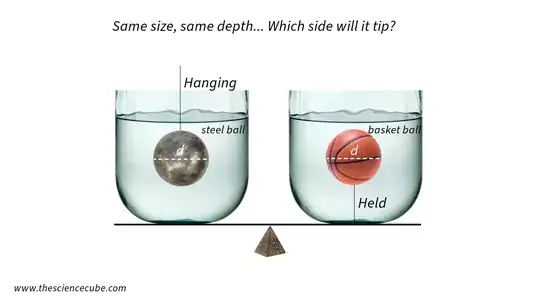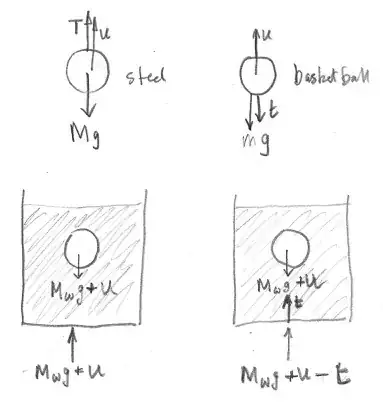The difference is the anchoring points, as others have said.
It helps me in these cases to just remember that the principle of buoyancy is a special case of the minimization of potential energy in static equilibrium. Consider that the left cup goes up and the right cup goes down by a millimeter, how has the energy changed? Assume that the rounding of the cups doesn't matter as if there were no balls the two would balance, so idealize those as perfect cylinders with some cross section area, say, $400\text{ cm}^2$, filled up maybe to $30\text{ cm}$. The balls inside are size-3 mini basketballs with a radius of $8.9\text{ cm},$ the steel being some 23 kilos and the normal one being 280 grams.
You can do this in two ways, "teleporting water" analysis or actual equations. If you analyze buoyancy by teleporting water, then when the cup holding the steel ball moves up by a millimeter, a volume of $0.1\text{ cm}\times400\text{ cm}^2=40\text{ mL}$ needs to be deleted from the bottom of the cylinder and then re-added at the top of the cylinder, it has “teleported” up by $30\text{ cm}.$ But on the right a separate $40\text{ mL}$ is displaced downward by $30\text{ cm}$, and these two effects cancel in terms of energy. And this is why if there were no balls, the scale would balance.
However, what changes with the ball on the right is that the steel ball on the left doesn't move but the basketball on the left has also dropped $1\text{ mm}$. The ball has some mass which lowers the energy, but it also will sweep out its cross section of $\pi r^2$ (roughly $250\text{ cm}^2$) for a millimeter and that water has to be teleported upwards as it sinks downwards, by an average distance $\frac43 r$ (roughly 12 cm). So you have 280 grams of basketball moving down by one millimeter, energy change roughly $-2.8\text{ mJ}$, but balanced out by 25 grams of water teleporting up by 12 centimeters on average, energy change roughly $+3.0\text{ mJ}$, and we know that the second number is always greater (in absolute value) than the first number because if it weren't, the ball wouldn't float in the first place.
Energy minimization therefore says that the floating basketball will pull its side up with its buoyant force, the steel ball will not push its side down with the same because it is suspended and unable to fall to reduce the potential energy.
In equations, we have the left hand side sitting at vertical position $+y$, the right hand side sitting at $-y$, the potential energies on the left and right are,
$$
U_L = \rho g\left(\pi R^2 h~\left[\frac{h}{2} + y\right] - \frac43\pi r^3~\frac{h}{2}\right) + m_\text{Steel} g \frac{h}{2},\\
U_R = \rho g\left(\pi R^2 h~\left[\frac{h}{2} - y\right] - \frac43\pi r^3~\left[\frac{h}{2}-y\right]\right) + m_\text{Basketball} g \left[ \frac{h}{2}-y\right].$$
It's a lot to write but you can see the above analysis poking through: when we form $U=U_L+U_R$ the leading $\pi R^2 h$ terms will add together to lose their y-dependence, and then when we compute the force the $\frac{dU}{dy}$ terms also disappear completely, leaving just $\frac43\pi r^3\rho-m_\text{Basketball},$ which is just the criterion for whether the basketball floats or sinks.

